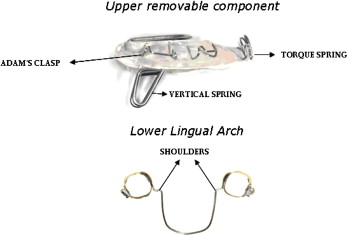Introduction
The aim of this study was to compare the effectiveness of Twin-block and Dynamax appliances for the treatment of Class II Division 1 malocclusion.
Methods
This was a randomized controlled trial involving 32 boys and 32 girls aged 10 to 14 years with Class II Division 1 malocclusion. They were randomly allocated to either the Dynamax appliance group or the Twin-block appliance group. Treatment was provided by 4 clinicians at 2 centers. Records were taken at the start and the end of the functional phase and after all treatment. In addition, incisal overjet, the number of appliance breakages, and adverse events or side effects of the treatment were recorded at each patient visit.
Results
The data monitoring committee in an interim analysis at 18 months after the start of the trial found significantly greater overjet reduction in the Twin-block group than in the Dynamax group and more breakages and adverse events with the Dynamax appliance. As a result, treatment with the Dynamax appliance was terminated, and those patients completed treatment with the Twin-block or a fixed appliance. Regression analysis showed a statistically significant difference in the performance over time between the Twin-block and Dynamax appliances in terms of reduction in overjet, with the Twin-block appliance performing significantly better than the Dynamax. The incidence of adverse events was greater in the Dynamax group (82%) than in the Twin-block group (16%), with a statistically significant difference ( P <0.001) between the 2 groups.
Conclusions
The Twin-block appliance was more effective than the Dynamax appliance when overjet was evaluated and the Dynamax appliance patients reported greater incidence of adverse events with their appliance than those who were treated with the Twin-block appliance.
Editor’s comment
The Dynamax appliance was developed in 2003 for the treatment of Class II malocclusion. Because of limited research into its effectiveness, these authors decided to conduct a randomized controlled trial to compare the effectiveness of the Dynamax and the Twin-block appliances for the treatment of Class II Division 1 malocclusion. See Figure 4 for a description of the flow of patients through the Dynamax treatment trial before the project was stopped because of the difficulty with continued use of the new appliance. Noted the primary author, “When the trial was stopped, 17 Twin-block patients and 5 Dynamax patients had completed the first functional phase of treatment. Seven Twin-block patients and 3 Dynamax patients had dropped out of the trial. In the Dynamax group, the clinicians decided to transfer 11 patients to Twin-block treatment, because they had too many breakages (3 patients), or overjet reduction was either minimal or nonexistent (8 patients). Seven patients were transferred to fixed appliance treatment. One patient in the Twin-block group was moved to headgear treatment.” The authors explained the patients’ stage of treatment when the trial was terminated, and, as a result, all 64 patients who started the trial were included in the data analysis.
The committee monitoring the outcome of the trial concluded that there was a significantly greater overjet reduction in the Twin-block group than in the Dynamax group and more breakages and adverse events with the Dynamax appliance. Perhaps more interesting to the casual observer is the resourcefulness of these investigators when their well-designed trial went bad, primarily because of appliance breakage and patient-compliance issues. Having an orthodontic clinical trial halted before completion certainly adds an interesting twist to the story.





